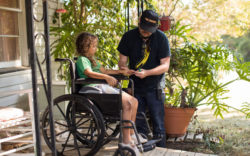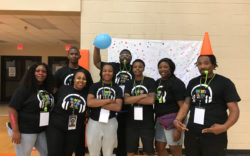Demond Means stood at a dry-erase board behind his desk drawing 20 circles.
He put a loop around four of them; these are the kids who are going to a special education class. Another loop went around five more; these are the kids going to a gifted class. Four more little circles got earmarked for an early intervention program.
Six circles were left—the students who remain for regular instruction. This, he said, is how our schools continue to be segregated in 2019.
“And this happens in schools across Georgia. We’re trying to stop it in Clarke County,” said Means, who is in his third year as superintendent of the Clarke County School District. “The point is, when you start pulling those kids out, that’s segregation. We’re perpetuating the gap. We’re actually fueling the gap in the name of ‘we’re helping them.’ But we’re not helping them; we’re making things worse.”
Reversing this practice is one of several ways Means is trying to change how the school district works, and he’s planning on achieving this through a multi-step equity training process. This process is essentially meant to rebuild the school district within its own walls.
It will take several years, Means said, but when the construction is done and the dust has cleared, ideally, all students will make progress year over year.
Putting a System in Place
In Clarke County, as in most places, black students’ standardized test scores lag behind their white counterparts. They’re also more likely to be disciplined, more likely to be placed in special education programs and less likely to be accepted into gifted programs or take AP classes. But, according to Means, all students—even high achievers—should see better results as a result of the equity process.
Elise Frattura, a professor at the University of Wisconsin-Milwaukee who is co-leading the equity training for the school district, said the segregation of students Means described is one of the main things holding Clarke County back. She and Colleen Capper, co-founders of Integrated Comprehensive Systems for Equity, have developed a system over the past 30 years that will take educators and administrators through a series of steps that, ultimately, are the foundation of the rebuilding process.
In Clarke County, the process began about a year ago with Step 1, which taught school principals, school leadership teams and district office staff about equity—what it means, how communities are marginalized and the role the educational system plays in this.
Following this three-day training, principals and school leadership teams then received the directive to fan out and work individually and in small groups of teachers to pass the same lessons along. This process takes time, Frattura said, to allow the training to fit into everyone’s schedules—and because of the high number of new principals in the past year, additional training sessions have taken place more recently to get everyone up to speed.
“We want people to know what inequities are. They have to know we created legislation that marginalized the African American population,” said Frattura. “But they also have to know the role of schools within that marginalization. We have to be able to look objectively and say, ‘OK, what has the role of education been in perpetuating societal marginalization? And not just people who are African American, but really anybody who doesn’t fit a perceived normative that isn’t white, middle class, cisgender and predominantly Christian.”
This sentiment is shared by Rhina Fernandes Williams, a clinical associate professor of critical and multicultural education at Georgia State University. Interviewed for her perspective on what equity looks like in the classroom, Fernandes Williams said teachers can often benefit from taking a hard look at themselves, their beliefs and attitudes, and how they play out in the classroom.
“Everything that happens in the classroom is filtered through teachers,” said Fernandes Williams, who challenges her own college students’ perceptions of education with the question, why school? “We all have biases. We all have beliefs about things. But whatever those things are, more often than not, it’s very hard to get into them without delving into, ‘How did I learn this?’”
Tearing Down Walls
The topic of separating students came up at a recent question-and-answer event at Normal Bar hosted by a local church. Means, speaking to a crowd of about 100 who had gathered on a weeknight, explained a solution to this modern-day segregation of students: Rather than pull them out into special classes, students would stay, and their teacher would work with other experts in the building to infuse lessons with additional activities or techniques that play to students’ strengths.
A table of teachers pushed back. How were they to address the needs of non-native English speakers or gifted students or special education students without additional teachers in the room?
Means said the answer was a concept called co-planning to co-serve, which meant teachers collaborated with gifted, ESOL, special education and other teachers to bring their expertise into the main classroom.
Frattura echoed this sentiment in a later interview with Flagpole. When students are grouped by ability, they are taught that they do not belong, she said. Over time, children learn who belongs and who does not. “We know from research that the more diverse an environment, the more everyone learns. Hands down. Because we learn from each other,” she added.
She recalled a situation in another school district where teachers and administrators had gone through the equity process, had classrooms that reflected the demographics of their schools, and students were excelling.
Then, in one school, a hiccup: Test scores went down. The only change, she said, was 30 minutes at the end of the day when a group of students deemed high-achieving were allowed to go outside and catch tadpoles, while another group of students stayed inside and worked on flashcards. But they could see the other students outside, and even in that 30-minute timespan, the children made the connection that they weren’t part of that group. Expectations fell, as did their test scores.
“And it makes sense, when we’re responding to deficits,” Frattura said. “When a system reverses itself and is proactive, it gives teachers more ability to work across more kids, and everyone does better.”
Moving Forward
In total, there are four main cornerstones in the ICS equity process. The second step will be implemented in December, said Frattura, when the team will work on forming cohesive and comprehensive instruction, laying the groundwork for co-planning to co-serve.
Frattura understands teachers’ frustration with the pace of the work. Many choose the profession because of their desire to make a difference, but when the system is working against you, it makes moving the needle impossible. “Most of us have the philosophy that if you want to make a difference, teach,” Frattura said. “But you’re not going to fix it by changing exactly what you do in the classroom. You can fix it, but it has to be systematic. Teachers can’t fix it, but they can be part of the process to fix it.”
Fernandes Williams said there are ways teachers can make their classrooms more equitable, but only after truly understanding what equity means and understanding ways our current system perpetuates issues such as poverty.
“And from there, it’s easier to think about, what do they see in all the texts? What do they see in children’s books? What do they see on the walls?” she said. “So, if you have populations who are diverse, you have children coming from different backgrounds. When teachers are aware, they can build on those.”
The third cornerstone, which Frattura expects to begin next fall, implements the co-planning to co-serve concept. The final piece of the training involves leveraging funding and policies to eliminate inequities. In total, she said, the process takes about three to five years—but once the concept catches on, she said, she and her team are quick to step out and let the district move forward with its own solutions.
“It’s hard. It is,” said Frattura. “And people have to be really kind and patient and loving to each other, because we’re kind of in this thing together.”
Means also acknowledged it’s a process, but he said it’s what he’s envisioned since he arrived in Clarke County more than two years ago. At the end of it, the gap in the data between white and black students should close because the culture inside schools has changed.
“It does require people to look at their work differently,” Means said. “It requires a level of urgency that maybe we haven’t felt before. But it’s an urgency I feel every day, because I don’t believe that our kids are unable to read on grade level simply because they’re of a certain ethnic group and they’re poor. What I do believe is that if we do our very best as professionals, we can raise achievement for children.”
Beyond Equity
Along with the training, Means laid out for Flagpole several other changes that have been implemented in the past two years with the goal of raising student achievement:
• A new English-language arts system called Fountas and Pinnell in grades kindergarten through fifth, which was based on teacher feedback and replaces a system that many found difficult to use. In middle school, teachers opted for the Lucy Calkins system.
• Eureka Math is now used in grades kindergarten through second.
• The district introduced AVID (Advancement Via Individual Determination), a framework that, Means said, helps to change the instructional relationship between the teacher and the student. AVID also includes extensive training for teachers in strategies. “The teacher becomes more of the facilitator of the learning instead of the director of the learning. I’ve seen it work in changing classroom culture,” said Means. AVID is not mandated but is in place in 18 of 21 schools.
• A new program, Learning Wednesdays, brings small groups of teachers to the district office for professional development and training, specifically in a new instructional model that includes an opening to a lesson, a transition, a work session, a summary and an assessment of what was taught.
The Role of Principals
Another change is a new instructional framework—and principals play a key role.
Means said teachers follow a set order to how a lesson is taught: an opening, a transition to a work session, a work session, a summary of what was taught and some type of assessment to be sure students understood what was taught. And it’s principals, he said, who are instrumental in supporting teachers in this framework.
“A principal should be in a classroom every day. Every day,” said Means. “If they’re not, they’re not serving as the instructional leader.”
Over time, Means said, principals can watch teachers, ask questions, offer pointers and then be at the table when follow-up meetings take place. If the students aren’t learning what was taught, how can it be retaught? What are the kids doing? “Then, you have a culture that’s no longer based on blaming, or suggesting social factors are the reason for student failure,” he said. “But it’s really making sure that the school system protocols and procedures are so focused on serving every child that we start to elevate our service.”
Anyone can manage a school, Means said. Instead, he wants people who are “master educators” to serve in the role of principals.
Means has also changed the reporting structure for principals across the district. Now, the three high school principals report to him, while the other principals are split among the district’s chief academic officer and two directors of support and principal supervision. The benefit to this structure, he said, is that it gives principals a specific contact in the district office if they have an issue, and that person can focus on the problem at hand.
“So, if there’s a challenge happening at your school, you call your person,” Means said. “And we typically say, ‘We got it from here, you just go back and run your school.’”
A previous version of this article mischaracterized the NWEA MAP testing.
Like what you just read? Support Flagpole by making a donation today. Every dollar you give helps fund our ongoing mission to provide Athens with quality, independent journalism.










